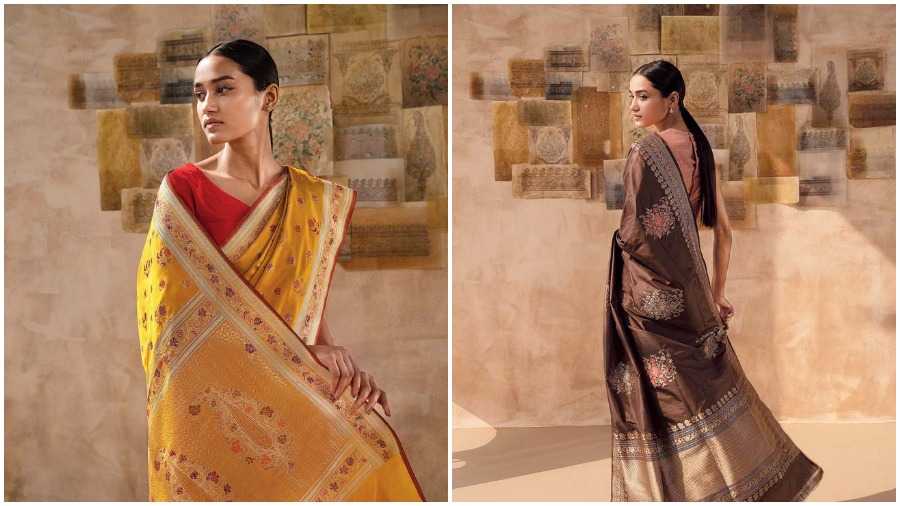Benaras-born brand Tilfi has gone back to their archives, which has resulted in ‘An Artist’s Legacy’. Aditi Chand, co-founder and CEO, Tilfi, tells The Telegraph about reviving decades-old designs and what makes a classic Benarasi.
‘An Artist’s Legacy’ is quite a heartening initiative. Have you been thinking about this for a while?
As someone wise once said, in our heritage crafts, we are always walking backwards into the future. At Tilfi, we are always tapping into our historical textiles whether for revival projects or as a springboard for innovation. Our family’s design archives are a tremendous resource, which we tend to frequent as a wellspring of ideas and inspiration.
While sifting through these files one day, we noticed fine designs which were carefully preserved and had a distinctive refinement that was hard to miss. On enquiring upon their origin, we found out that they were created for us over two decades ago by Jadunath Supakar. What also unravelled were countless memories of our father having worked with the artist, witnessing his creative process. In that instant, we knew that this was a project worth pursuing.
Benaras is full of stories of contributors to our heritage crafts, artists who dedicate their creative careers to our handloom industry. Their work and legacies need to be celebrated.
The collection looks lovely. What has been the process like?
It has taken us close to two years to complete the collection and prepare for launch, and the entire process has been very fulfilling. In the beginning, all we had were delicate paper illustrations, which were like pieces of a puzzle — individual motifs, fragments of a border, a solitary paisley…. All these had to be recreated, completed and placed to form a holistic design, fit for a sari. Once the design was completely visualised and developed, it had to be translated into textiles in the most authentic way possible.
In order to do justice to the design legacy of the master artist, we approached his son, Sribhas Chandra Supakar, a renowned textile designer himself. He agreed to participate in this revival project and led the way towards recreating the magic of his father’s artworks. Along with him, several other textile designers collaborated with us to develop the designs which were eventually commissioned to be woven. Like all our textiles, certain decisions on materials, techniques and colours were taken post an iterative process of sampling and improvisation, as swatches were woven and evaluated repeatedly. Some of our most dedicated master weavers and weavers participated in this process.
How many saris did Sribhas Chandra Supakar work on?
Out of the seven distinct designs of J.N. Supakar that we have recreated in this collection, his son, Sribhas Chandra Supakar worked to complete four.
How different are their aesthetics and was this blending of two generations a challenge?
While the individual elements used in these textiles had Jadunath Supakar’s creative stamp all over them, what was challenging was piecing them together in a way that most closely resembled the artist’s natural style and aesthetic. This was extremely important since we were completing his artworks and dedicating this collection to celebrate his legacy.
Sribhasji knew his father’s artistic inclinations and style most intimately and intuitively, and that also presented the biggest challenge. One of J.N. Supakar’s talents was the way he could achieve balance and harmony in the placement and fineness of his designs. To Sribhasji, this perfection in balance was an ideal to aspire to.
What are your personal favourites?
I love the perfect beauty of the paisley which adorns the pallu of the Chitragandha sari. It was also one of my favourite illustrations from Mr Supakar. The Kasturi and Guldasta saris are both stunning in their apparent simplicity, but incredible in the fineness of their details. There is a visual ease in both these designs.
What did this project teach you?
This project truly illustrated the collaborative nature of the Benarasi weaving community. So many hands of designers and artisans came together to complete a project which paid homage to one of their own. It also taught us the value of looking into the works before our time. Artistic legacies are also a great medium to help nurture and nourish new talent.
This is really the need of the hour, right?
We believe for crafts to truly flourish, artists and craftsmen need to be celebrated. Making them central to the conversation about our textiles and designs will ensure that they continue to take pride in their arts.
Are you planning more such projects?
Certainly, we will continue to work on projects where we dive into the past to create products for the future. We also hope to bring to the fore many incredibly talented textile designers of Benaras who have dedicated their lives to the craft, yet remain little known outside core craft and textile circles.
How are you experimenting with Benarasis this season?
For us, innovating in our textiles is a constant process. We love to play around with different yarn combinations, different visuals that can be achieved using classic techniques and different interpretations of our weaves.
Although there are no seasons at Tilfi (we cater to almost 15 time zones across hemispheres) we are quite excited about what is next. We’re exploring many contemporary interpretations of our textiles and will be launching a line of saris and apparel which we consider to be “neo-Banarasi”.
What’s an all-time classic Benarasi?
An all-time classic Benarasi is one whose beauty is unaffected by passing trends! Like any work of art, it may not be a conventional choice at all, but one that speaks to you and moves you each and every time you look at it.

